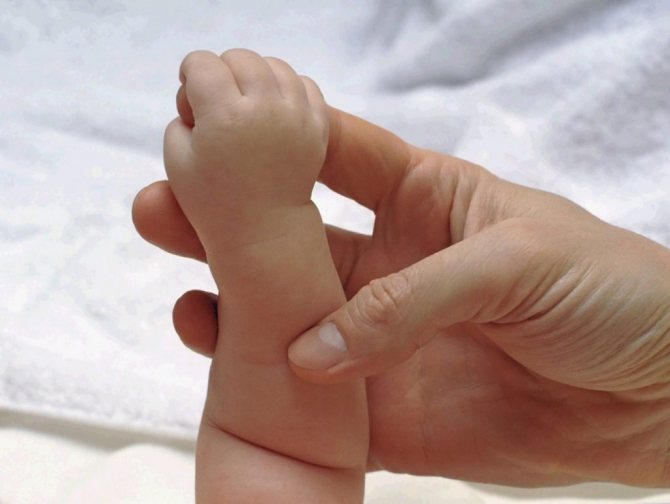We teach and help the child to roll over
In order to prepare your baby for rolling over, you need to do daily exercises that will strengthen the muscles of the whole body. Such exercises include:
- Alternately bend and unbend the child’s legs. This exercise is similar to a “bicycle”.
- You need to give your baby his fingers so that he can grasp them tightly. Then bend and straighten the baby’s arms on the chest.
- Let the baby grab your fingers, then pull the baby up a little. Gradually the muscles will strengthen and the baby will try to get up on his own.
- Place the baby on his stomach more often. This exercise will help strengthen your back. When the baby gets stronger, his activity will increase, he will learn to hold his head and lean on his arms.
- It is necessary to do gymnastics after a preliminary massage. This will help warm up and prepare your muscles. The duration of the gymnastics should be about 10-15 minutes.
How to teach your baby to roll over
All the basic skills of a child need to be taught, since he does not yet have an idea of how this or that movement is performed. Unconsciously rolling over is not considered a skill. Nevertheless, it is precisely this that gives a signal to parents: it’s time to start studying with the baby. This should be a game in which the stimulus will be the mother’s smile (the most valuable reward for a child in infancy) and verbal approval.
Useful exercises
Pediatricians, including Dr. Komarovsky, believe that classes can be combined with air baths: this will undoubtedly increase the benefits for the baby. For lessons to be effective, you should follow a few simple rules:
- play 30–40 minutes after eating;
- exercise regularly 2-3 times a day (it is better to coordinate the frequency with your pediatrician);
- ventilate the room before starting classes (optimal air temperature is 19 degrees);
- cover a hard surface with a soft diaper, for example, a changing table;
- Start classes only if the child is in a good mood.
Exercises for mastering the skill of turning over from the stomach to the back are, in essence, strengthening the baby’s muscular system. You can start exercising from the first month of life.
"Bike"
Exercise “Bicycle” is useful for all muscle groups
Instructions:
- We bend and unbend the baby's legs, constantly alternating them.
- Do it in no more than 2 minutes.
"Capture"

. Instructions:
- We help the baby grab his mother's index fingers with his hands.
- Holding the baby’s fingers, we spread and bring our arms together on our chest.
- We perform for about 2 minutes.
"Pull-ups"

. Instructions:
- The starting position is the same as in the previous exercise - the baby grabbed his mother’s fingers.
- Mom carefully pulls the baby towards her.
- Perform 2-3 times at a slow pace.
Laying on the stomach
You can place your baby on his tummy already in the first month of life, when the umbilical wound has healed. At first this will take no more than a minute. If the baby likes this position, you can gradually increase the time. Usually it lasts up to 10 minutes (after which the exercise becomes irrelevant, since the child can roll over on his own). Laying on the stomach is very useful, as it helps strengthen the neck muscles and teaches the child to hold his head.

You can place your baby on his stomach almost from birth.
You need to allocate about 15 minutes to complete this set of exercises.
Video: how to teach a child to roll over
How to help your baby roll over
To make learning easier and more interesting, you need to:
- Carry out training, gymnastics and massage on a flat and hard surface.
- In order for the child to have an incentive, you need to put an interesting and bright toy that will attract the child’s attention and he will be drawn to it.
- You should only practice when the child is in a good mood.
- Before you start gymnastics, the baby needs to be undressed. This way it will be more convenient and you can harden your child at the same time as doing gymnastics.
We teach the baby to roll over from his stomach to his back, from his back to his stomach

By three months, all babies become more active. They don’t want to just lie down at all, they try to reach the toy, stretch, try to roll over on their side, and from side to tummy and back. This moment usually occurs between three and four months. At four months, the baby will most likely be able to turn on his side, and by five months he will be able to roll over from his stomach to his back, and from his back to his stomach. But you should not compare one child with another, since all children develop individually.
Exercises to help you roll over from your back to your stomach

- The child needs to be laid on his back, then his attention should be drawn to some bright and interesting toy. Move the toy in front of the baby and when he wants to reach out and take it, the toy should be placed on the side of him. When the baby almost turns over, the toy needs to be moved towards him. This will be some incentive to roll over.
- Place the child on his back. Bend one leg at the knee and move it in the direction you want to turn. The baby will reflexively pull the handle behind his leg. Over time, the child will learn to do this on his own.
- The child should lie on his back. You need to give him a finger to grab and create support for his legs with his hand. With support it is much easier for the baby to roll over.
- In order for the baby to lie more confidently on his side, it is necessary to place him on his side and create support for his back. You can hang a beautiful toy in front of your child, thereby attracting his attention.
- The baby should be placed on its side. Hold him by the shoulder and move your pelvis in the direction you want to roll over. Then you should do the opposite, fix the pelvis, and move the shoulder to the side. This will help the baby to awaken the desire to roll over.
How to teach a child to roll over onto his back
Follow simple exercises and your baby will soon master turning over onto his back.

First exercise
Place your baby on his stomach and stand at his feet. Stretch your baby's right arm forward and show him some bright toy. If necessary, bend your baby's left leg. Now move the toy to the left. The baby will begin to follow the toy and turn over spontaneously.
Second exercise
Roll your baby on the ball, placing him first on his stomach and then on his back. This will be useful for the child in developing motor skills.
Third exercise
Place your baby on his stomach and stand at his feet. Bend the baby's right leg at the knee and then at the hip joint. Now carefully move your right leg behind your left. Watch the baby. He should rise up on his elbows and gradually roll over onto his back. Try this exercise by bending your baby's left leg. And so on several times.
Exercises to help you roll over from your stomach to your back

- The baby should be placed on his stomach. Stand behind and move a bright toy in front of the child at a distance. When the baby becomes interested in the toy, you need to help him reach for the toy with one hand. Then begin to move the toy away so that the baby turns over on his back, reaching for it.
- The baby is lying on his stomach. It is necessary to bend his left leg and move it behind the right one. The baby will most likely lift himself up in his arms and roll over. During this exercise, you need to support the child, as he may hit himself from a sharp turn.
- It is necessary to lift the baby so that, lying on his stomach, he lifts himself up in his arms. This will strengthen the muscles.
All exercises must be done on both the left and right sides the same number of times so that the child develops evenly. One exercise should last at least three minutes. It is best to repeat the exercises 2 times a day.
In order for the baby to develop faster, in addition to gymnastics, it is necessary to do:
- Massage. It allows you to strengthen muscles and relieve tone in children.
- Finger massage. Positively affects speech and thinking.
- Swimming. Strengthens joints and muscles, stimulates the immune system and develops the vestibular apparatus.
- Hardening. Helps strengthen the immune system.
- Fitball. Promotes muscle development throughout the body. Great for babies from two months. There are many exercises on a fitball, as well as for quickly mastering flips.
The main thing during exercise is to be patient and not to be too persistent. After all, every child is individual and develops in his own way.
How to properly teach to roll over from your stomach?
The period when the baby begins to crawl depends on how quickly and correctly learning to roll over occurs.
Typically, crawling occurs soon after the development of this skill, so you should not be surprised when the baby crawls on his own.

An important procedure is teaching a newborn to roll over from his tummy:
- Place the baby stomach down, you yourself are behind the baby. Show the toy in front of your face, make it so that the baby can reach it with his hand. As soon as the baby tries to take it, slowly move the object up and to the left. Following the movements of the hand, the baby will easily roll over.
- The second exercise completely copies the task with which it is necessary to teach a child to roll over onto his stomach. It must be done the other way around - place the baby on his tummy, cross his left leg behind his right. Let your child grab a finger - this will provoke a coup.
- Briefly pick up your baby while he is lying on his stomach. It is important that the baby pushes himself away from the crib with his hands. Movements should not be sudden, everything is done smoothly.
Dr. Komarovsky argues that a child’s reluctance to roll over is not always a developmental deviation.
The reasons for this phenomenon may be individual characteristics of temperament, nuances of physique, prematurity, and excessive fatness.
Important! A thin and flexible baby begins to roll over much earlier than his plump counterpart: this is not a reason to panic.
Don’t be nervous about your baby’s reluctance to develop this skill; it’s better to use these recommendations and exercises to smoothly guide your baby to the start of development.
Useful video
Share this post
- Related Posts
- Mental and physical development of a child at 10 months, as well as games and activities with the baby
- How to distinguish newborn acne from allergies and what are the methods for treating it
- For what reasons does the eye of a newborn fester, what does Komarovsky advise and how can it be treated?
- Why are nipple shields needed and how to use them
- Code of conduct in the forest: for children and schoolchildren
- Vaccination schedule for children under 1 year of age against pneumococcal, rotavirus and other infections, as well as possible reactions
Exercises for training the roll from back to stomach
Alexey Luzhkov, specialist in early physical development of children
When did your child start to roll over? This is not an idle question, which young mothers often ask each other - the skill of turning over is very necessary in order to learn to crawl. It can be mastered after the child learns to lie on his stomach. If your baby does not try to roll over onto his stomach by 3 months, you need to help him with this.

Babies usually begin to master turning from back to stomach at 3 months. As a rule, by 4 months, most are already able to independently and purposefully roll over from back to stomach in full.
However, we must understand: in order for a child to learn this movement and begin to roll over, he must be able and willing to simply lie on his stomach. You also need to create an incentive for the desire to roll over. For example, toys should not hang from above the head, but lie to the side, etc.











